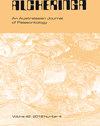A sea scorpion claw from the Lower Devonian of China (Chelicerata: Eurypterida)
IF 1.5
4区 地球科学
Q3 PALEONTOLOGY
引用次数: 7
Abstract
Wang, B. & Gai, Z.K., 2014. A sea scorpion claw from the Lower Devonian of China (Chelicerata: Eurypterida). Alcheringa 38, XX–XX. ISSN 0311–5518. An isolated chelicera (claw) of a pterygotid eurypterid is described from the Lower Devonian Xitun Formation of Yunnan Province, China. It is different from chelicerae of other pterygotids in having four principal denticles and at least four intermediate denticles between the principal denticles on both rami. This Chinese pterygotid, estimated at about 70 cm long, was a top predator that probably hunted small, primitive fishes, such as galeaspids. This discovery represents the first record of Pterygotidae from Asia and the third fossil eurypterid from China. Bo Wang (corresponding author) [savantwang@gmail.com], State Key Laboratory of Palaeobiology and Stratigraphy, Nanjing Institute of Geology and Palaeontology, Chinese Academy of Sciences, Nanjing 210008, China; Steinmann Institute, University of Bonn, 53115 Bonn, Germany; Zhikun Gai [gaizhikun@ivpp.ac.cn], Key Laboratory of Vertebrate Evolution and Human Origins of Chinese Academy of Sciences, Institute of Vertebrate Paleontology and Paleoanthropology, Chinese Academy of Sciences, Beijing 100044, China. Received 22.10.2013, revised 15.11.2013, accepted 20.11.2013.中国下泥盆世海蝎爪(螯角目:海蝎目)
王斌,盖志宽,2014。中国下泥盆世的海蝎爪(螯角目:海蝎目)。Alcheringa 38, XX-XX。ISSN 0311 - 5518。描述了云南下泥盆统西屯组翼足类泛翅龙的一分离爪爪。不同于其他翼足类的螯肢,它有四个主齿,在两支主齿之间至少有四个中间齿。这种中国翼龙,估计长约70厘米,是一种顶级捕食者,可能捕食小型原始鱼类,如galeaspids。这一发现是在亚洲发现的首个翼龙科化石,也是在中国发现的第三个泛龙化石。王博(通讯作者)[savantwang@gmail.com],中国科学院南京地质古生物研究所古生物与地层学国家重点实验室,江苏南京210008;德国波恩大学斯坦曼研究所,德国波恩53115;盖志坤[gaizhikun@ivpp.ac.cn],中国科学院古脊椎动物与古人类研究所,中国科学院脊椎动物进化与人类起源重点实验室,北京100044。2013年10月22日收稿,2013年11月15日改稿,2013年11月20日收稿。
本文章由计算机程序翻译,如有差异,请以英文原文为准。
求助全文
约1分钟内获得全文
求助全文
来源期刊

Alcheringa
地学-古生物学
CiteScore
2.60
自引率
7.70%
发文量
28
审稿时长
>12 weeks
期刊介绍:
Alcheringa : An Australasian Journal of Palaeontology is the official journal of the Australasian Palaeontologists.
Alcheringa covers all aspects of palaeontology and its ramifications into the earth and biological sciences, including:
Taxonomy-
Biostratigraphy-
Micropalaeontology-
Vertebrate palaeontology-
Palaeobotany-
Palynology-
Palaeobiology-
Palaeoanatomy-
Palaeoecology-
Biostratinomy-
Biogeography-
Chronobiology-
Biogeochemistry-
Palichnology.
Review articles are welcome, and may be solicited from time to time. Thematic issues are also possible. Emphasis is placed on high quality and informative illustration, in both line drawings and photographs. Papers of general significance may receive preference over those of more local interest.
 求助内容:
求助内容: 应助结果提醒方式:
应助结果提醒方式:


